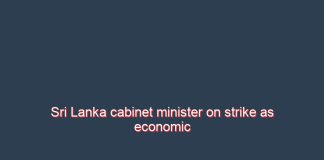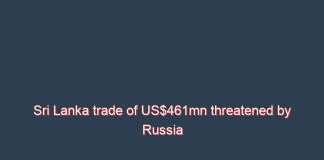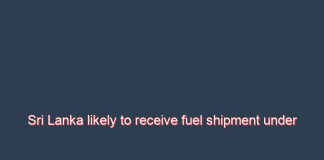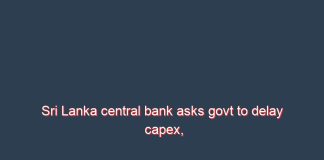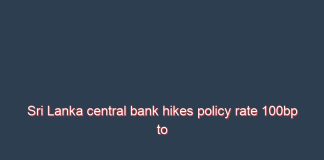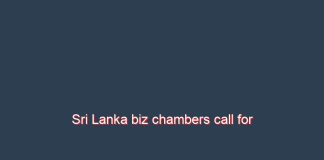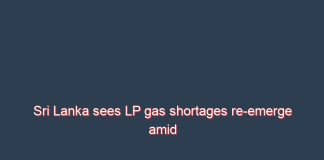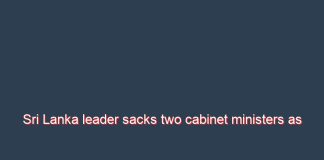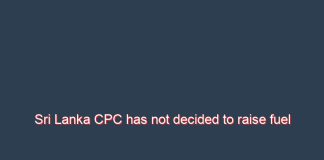Carl Muller – Yakada Yaka
Sri Lanka cabinet minister on strike as economic crisis sparks ruling...
ECONOMYNEXT – Sri Lanka’s Water Supply Minister Vasudeva Nanayakkara said he will not attend cabinet meeting or work at his office in protest over the sacking of two colleagues by President Gotabaya Rajapaksa in the latest internal squabble in the ruling coalition.
President Gotabaya Rajapaksa on Thursday sacked Udaya Gammanpila from energy minister portfolio and Wimal Weerawansa from industries minister. Both were cabinet ministers.
“I have withdrawn from ministerial duties,” Nanayakkara, told reporters flanked by his sacked colleagues Friday (04).
“I will not involve in any ministerial duties. I will not attend cabinet meetings. I urge justice for this wrong decision.
“The government should accept that it made a mistake and rectify it. If not, I will not go for cabinet for next three years and I will not fulfill any cabinet responsibilities for the next three years.
Friday’s drama is the latest twist in a series of internal squabbles of the ruling coalition, which had been intensifying as inflation picked up and forex shortages led to fuel and power and shortages.
“Now that we two are sacked, dollars will multiply, oil will spring from the ground, power cuts will end, and great miracles are due to happen,” Weerawansa said.
Socialist-leaning Nanayakkara’s Democratic Left Front (DLF) along with 10 small parties including the two led by Gammanpila and Weerawansa have been in the ruling Sri Lanka Podujana Peramuna (SLPP)-led coalition government after the August 2020 parliamentary poll.
Both Gammanpila and Weerawansa who have uneasy relations with Finance Minister Basil Rajapsaksa said they have been in bad books of the government after opposing a deal to give a take-or-pay liquefied natural gas deal, an LNG terminal and sell a power plant to US-based New Fortress Energy as well as a port terminal involving India.
The duo blamed Finance Minister Basil Rajapaksa, brother of President Rajapaksa for a worsening forex crisis, triggered by money printed to keep interest rates down amid an expanding budget deficit.
Weerawansa said Prime Minister Mahinda Rajapaksa, another brother, was not involved in the decision to sack them, saying he had superior political acumen.
Both Gammanpila and Weerawansa, with nationalist leanings, helped President Rajapaksa secure a landslide in the 2019 presidential and the last parliamentary polls.
The SLPP, which the duo described as the ‘personal property’ of Basil Rajapaksa has 145 members in the 225 member parliament and commands a two thirds majority with the support of several other legislators.
The Sri Lanka Freedom Party, led by former President Maithripala Sirisena with 15 members has also been critical of the administration as economic woes deepened.
Vasudeva, Gammanpila, Weerawansa and 14 Sri Lanka Freedom Party members contested through the SLPP ticket.
Nanayakkara said he and like-minded colleagues wanted to create a shelter for the two who had now been orphaned but decline to elaborate.
Weerawansa sidestepped a question whether they would join forces with Sirisena and other dis-affected member of the SLPP, as the forex crisis, shortages and queues made the electorate unhappy.
He denied plans to join the main opposition Samagi Jana Balawegaya.
Many governments over the past 70 years in Sri Lanka had been brought down by the high inflation, forex shortages, import controls and social unrest triggered by a money printing central bank set up in 1950 with US help.
The SLPP also came into power after two currency crises were triggered by the agency during the last administration following ‘flexible’ or discretionary monetary policies.
The agency claiming to operate flexible inflation targeting, also engaged in real effective exchange rate targeting and output gap targeting.
It also claimed to operate a flexible exchange rate, which collapses suddenly after money printed for output gap targeting (also known as stop-go policies), but is not flexible in other direction when economic output collapses due to REER targeting allowing the exchange rate to strengthen.
Analysts and economists had called for reform of the central bank law to take away the discretionary powers of its governing monetary board to prevent currency collapses, growth volatility, high inflation and social unrest.
After the latest bout of money printing, probably the worst in the agency’s history, the International Monetary Fund has warned that the country’s debt was unsustainable and the economy risked an implosion. (Colombo/Mar04/2022)
Sri Lanka trade of US$461mn threatened by Russia invasion of Ukraine
ECONOMYNEXT – Sri Lanka’s external trade of 461 million dollars with Russia and Ukraine is under threat, an official said after Vladimir Putin’s invasion of the neighbouring nation, triggered a humanitarian crisis and sanctions.
“Russia and Ukraine war could have impacts on the Sri Lankan exports because some of our exports, mainly tea goes to the region,” Anil Perera, Director of Economic Research at Sri Lanka’s central bank told reporters in Colombo.
According to central Sri Lanka exports 10.2 percent of tea to the Eastern European region.
Russia is one of the top Sri Lankan tea buyers.
Total exports to Russia and Ukraine amounts to 179 million US dollars a year or 1.4 percent of the total exports.
Total imports from Russia and Ukraine is 282 million US dollars (1.4% of total imports).
Perera said wheat imports could be affected.
Commodity prices and oil, already hit by Jerome Powell’s money printing, has soared after Putins’ war.
Thursday Brent crude rose to 117 dollars per barrel, the highest in eight years, against 96 dollars on February 22.
Russia and Ukraine are among the top five wheat exporters in the world.
Sri Lanka imports base metal, wheat and coal from Ukraine and Russia.
Russian and Ukrainian tourists have also been flocking to Sri Lanka.
In the first two months of the year, Russia brought 28,818 visitors and Ukraine 13,062 visitors.
“These geopolitical tensions could have some impacts on tourism, but we think Sri Lanka’s tourist source markets are diversified and the on-going tension will not be that high,” Perera said.
The Ruble has collapsed from around 77 before Putin’s war to around 110 to the US dollar which may make tea and holidays more expensive to Russians. (Colombo/Mar04/2022)
Sri Lanka likely to receive fuel shipment under Indian credit this...
ECONOMYNEXT – Sri Lanka is likely to start receiving fuel shipments from India under a 500 million US dollars before end of this month the whole process has been fast tracked due to the island nation’s ongoing fuel shortage, official sources said.
Sri Lanka’s fuel shortage has resulted in an unprecedented over 7 hour power cut daily and long queues at fuel stations across the country as the country failed to purchase fuel due to forex crisis.
Sri Lanka originally expected to get under a 500 million US dollar fuel under the credit line in the first week of April.
“We are likely to receive Indian oil parcels as soon as this month as they are fast tracking the process,” an energy ministry official told EconomyNext.
Government Ministers have claimed that power cuts can be ended from March 05, after a furance oil ship with 30,000 metric tonnes arrives.
However Ceylon Electricity Board officials have said power cuts can be reduced but not eliminated even if all thermal plants are run since hydro storage is depleted.
“We have now floated tender to buy Indian fuel. The tender includes diesel, petrol, and aviation fuel. What we know is they (India) is expediting the process now,” the energy ministry official said.
Indian Oil Corporation was quoted as saying in Indian media that it will supply 12 to 13 shipments of diesel, petrol and jet fuel to Sri Lanka over the next 4-5 months.
An Indian official who is aware of the ongoing discussion between the both countries over the fuel credit line confirmed the fast tracking process.
“The shipments will come before April first week,” he said. (Colombo/March04/2022)
Sri Lanka central bank asks govt to delay capex, raise taxes,...
ECONOMYNEXT – Sri Lanka’s central bank has asked the government to delay capital projects, raise taxes and sell off state assets to reduce the deficit and help bring a currency crisis brought about by money printed to keep rates as deficits expanded, under control.
The central also raised its policy rate at which new money is printed 100 basis points to 7.50 percent, through inflation at 15.1 percent is still more than double the rate.
The central bank has proposed “increasing government revenue through suitable tax increases on a sustained basis,” and “monetising the non-strategic and underutilised assets” which will raise revenues.
At the same time central bank called to delay capital projects which will reduce the import of building materials and machinery.
In 2021 building materials imports were 1.24 billion rupees, and machinery and equipment were 2.8 billion dollars.
The central bank had earlier decreed housing loans at 7.0 percent while printing money.
Analysts have called for value added tax to be raised to 20 percent to boost revenues and prevent a steep depreciation of the currency and possible loss of control of reserve money which may end up in dollarization.
The following measures were proposed.
a) introducing measures to discourage non-essential and non-urgent imports urgently based on the previous recommendation made by the Central Bank
b) increasing fuel prices and electricity tariffs immediately, to reflect the cost
c) incentivising foreign remittances and investments further
d) implementing energy conservation measures, while accelerating the move towards renewable energy
e) increasing government revenue through suitable tax increases on a sustained basis
f) mobilising foreign financing and non-debt forex inflows on an urgent basis
g) monetising the non-strategic and underutilised assets, and
h) postponing non-essential and non-urgent capital projects.
Sri Lanka central bank hikes policy rate 100bp to counter forex...
ECONOMYNEXT – Sri Lanka’s central bank has hiked interest rates 100 basis points in a bid to reduce money printing as forex shortages worsened amid as tourism recovered.
The central bank said the rate at which new money is printed would be raised 100 basis points to 7.50 percent.
The rate is still half the 15.1 percent inflation in February 2022.
The central bank said considering the severity of external problem and disruptions to domestic economic activity “a comprehensive policy package containing both traditional and non-traditional measures, along with other initiatives that have an impact on the overall economy, is essential to counter such economic headwinds.”
Forex shortages – a problem related to pegged exchange rates – is a result of excess demand, including from domestic credit driven by liquidity injections made by a central to enforce a policy rate or finance deficits.
The private sector is a net saver in Sri Lanka and cannot create forex troubles on its own, unless the savings are recycled through credit to generate imports.
The central bank has printed money to keep interest rates artificially low, undermining the exchange rate and triggering parallel exchange rates as the excess money tried to rush out of the country.
The central bank is now printing money after giving reserves for imports. More money is also printed in a quasi-fiscal activity to give incentives to remittances after money printing and tightened exchange controls created parallel exchange rates.
A float, after domestic credit is slowed can end sterilized interventions and also unify the parallel exchange rates.
The central bank also proposed a series of other measures which would increase revenues and reduce the deficit and domestic credit.
The agency said “as its Economic and Financial Advisor, the Central Bank wishes to advise the Government to diligently consider;
a) introducing measures to discourage non-essential and non-urgent imports urgently based on the previous recommendation made by the Central Bank
b) increasing fuel prices and electricity tariffs immediately, to reflect the cost
c) incentivising foreign remittances and investments further
d) implementing energy conservation measures, while accelerating the move towards renewable energy
e) increasing government revenue through suitable tax increases on a sustained basis
f) mobilising foreign financing and non-debt forex inflows on an urgent basis
g) monetising the non-strategic and underutilised assets, and
h) postponing non-essential and non-urgent capital projects.
The full statement is reproduced below
The Central Bank of Sri Lanka further tightens the Monetary Policy Stance
Global economic growth to moderate, while inflation to remain higher
As per the January 2022 update of the World Economic Outlook (WEO) of the International Monetary Fund (IMF), the global economy is expected to moderate from 5.9 per cent in 2021 to 4.4 per cent in 2022. The recovery in the global economic activity is expected to weaken due to the spread of the Omicron COVID-19 variant, supply chain disruptions and geopolitical tensions in Eastern Europe. Global inflation is expected to remain high and persistent due to elevated energy prices and continuing supply chain disruptions, prompting stronger monetary policy responses by central banks globally.
Global and domestic developments have posed challenges to the recovery of the Sri Lankan economy
The domestic economy is expected to make headway underpinned by the successful COVID-19 vaccination drive of the Government and relaxed mobility restrictions. However, economic activity is somewhat affected by recent adverse developments in the global front, in terms of supply chain disruptions and rising commodity prices, as well as in the domestic front, particularly in the form of power and supply interuptions. These disruptions have to be addressed immediately to ensure the continuation of uninterrupted domestic production and the momentum in exports, while continuing with the efforts to strengthen the production economy through well-targeted growth policies.
External sector faces heightened challenges
Although earnings from merchandise exports continued to record over US dollars 1 billion for the eighth consecutive month in January 2022, expenditure on imports continued to increase at a higher pace. Tourist arrivals increased noticeably thus far during the year, although recent geopolitical tensions may affect the tourism industry to some extent.
Meanwhile, a rebound in workers’ remittances is expected in the period ahead as worker migrations have increased notably and due to the measures taken to combat illegal money transfers, while encouraging remittances through formal channels via several incentives.
The Sri Lanka rupee was maintained broadly stable, while the gross official reserves as of end January 2022 are provisionally estimated at US dollars 2.4 billion, equivalent to 1.3 months of imports. At the same time, the Government and the Central Bank have been avidly pursuing avenues to attract fresh foreign exchange inflows while facilitating continued domestic economic activity. 2
Market interest rates are trending upwards
The expansion of domestic credit, particularly credit to the public sector was robust. Nevertheless, some slowdown in the growth of broad money (M2b) was observed due to the decline in net foreign assets (NFA) of the banking system. Following the monetary tightening measures, market interest rates are adjusting upwards.
However, the adjustment in deposit interest rates remains sluggish, which has been inadequate to attract deposits into the banking system from the excessive currency in circulation. Therefore, banks and financial institutions are urged to make the required adjustments to deposit interest rates in order to promote savings. Meanwhile, yields on government securities have also increased notably to reflect market conditions in view of the higher financing requirement of the Government.
Supply side factors have contributed to price pressures, while the build-up of aggregate demand pressures is also visible
Supply side disruptions, increasing global commodity prices and associated domestic administrative price adjustments, and food supply disruptions have been the key drivers of rising inflationary pressures domestically.
The acceleration in core inflation also reflects the firming up of aggregate demand conditions in the economy propagated by the accommodative monetary conditions and fiscal measures that were in place since the onset of the pandemic. While inflationary pressures are expected to remain elevated in the near term, the pressures emanating from the build-up of aggregate demand require proactive measures to anchor inflation expectations and retrace inflation to the desired levels over the medium term.
A policy package to support greater macroeconomic stability
Considering the severity of the external shocks and continued disruptions to domestic economic activity, the Monetary Board was of the view that a comprehensive policy package containing both traditional and non-traditional measures, along with other initiatives that have an impact on the overall economy, is essential to counter such economic headwinds.
Accordingly, after carefully considering the current and expected macroeconomic developments both globally and domestically, the Monetary Board of the Central Bank of Sri Lanka, at its meeting held on 03 March 2022, decided to reinforce its stance adopted in January 2022, and decided to:
a) increase the Standing Deposit Facility Rate (SDFR) and the Standing Lending Facility Rate (SLFR) of the Central Bank by 100 basis points each, to 6.50 per cent and 7.50 per cent, respectively;
b) revise upwards the caps imposed on interest rates applicable to credit cards to 20 per cent per annum, on pre-arranged temporary overdrafts to 18 per cent per annum, and on pawning facilities to 12 per cent per annum. Directions to effect these regulated interest rates will be issued shortly.
The Monetary Board was of the view that the above measures will dampen the possible build-up of underlying demand pressures in the economy, which would, in turn, help ease pressures in the external sector, thus promoting greater macroeconomic stability.
At the same time, concerted efforts will need to be urgently taken by the Government to complement the efforts taken by the Central Bank to overcome the present economic challenges. Therefore, as
its Economic and Financial Advisor, the Central Bank wishes to advise the Government to diligently consider;
a) introducing measures to discourage non-essential and non-urgent imports urgently based on the previous recommendation made by the Central Bank
b) increasing fuel prices and electricity tariffs immediately, to reflect the cost
c) incentivising foreign remittances and investments further
d) implementing energy conservation measures, while accelerating the move towards renewable energy
e) increasing government revenue through suitable tax increases on a sustained basis
f) mobilising foreign financing and non-debt forex inflows on an urgent basis
g) monetising the non-strategic and underutilised assets, and
h) postponing non-essential and non-urgent capital projects.
The above measures would ensure that a coordinated approach is adopted to overcome the challenging economic circumstances faced by the country and to prudently exit the COVID-related policy accommodation.
The Central Bank will continue to closely monitor the emerging macroeconomic and financial market developments, both globally and domestically, and will stand ready to take further measures as appropriate, with the aim of achieving stability in the fronts of inflation, the external sector and the financial sector, thereby supporting real economic activity on a sustained basis.
Sri Lanka biz chambers call for debt-restructuring, IMF deal, market pricing...
ECONOMYNEXT – Sri Lanka’s main business chambers have called for debt-restructuring after the International Monetary Fund said the country’s debt was unsustainable and also called for market pricing of fuel and electricity and a formal program with the Fund.
Sri Lanka is experiencing severe forex shortages due to money printed to maintain low interest rates of 6.5 percent. Money is being printed from around October despite higher market rates, due to sterilizing reserve sales for imports.
Reserves, which are accumulated savings of past years, are not expected to be used for consumption imports.
Sri Lanka has used 967 million US dollars in reserves for interventions since October.
Related
Sri Lanka spends US$967mn in ‘reserves for imports’
Reserves were last used for intervention at current levels in a 2018 currency crisis. In the absence of money printing, reserves are not used for imports, but reserves are slowly collected at a market driven interest rate by contracting credit.
Nine business chambers in Sri Lanka called for the following measures:
Establish a market driven pricing formula for fuel, gas and electricity while also allowing flexibility on the exchange rate. We are of the view that it is better to manage a situation of cost escalations compared to the present shortage of essential items including foreign exchange which is crippling economic activity.
Immediately commence a preemptive foreign debt restructuring process in an orderly manner.
This should involve restructuring of both commercial and non-commercial debt. We feel commencing this process soon will provide a breathing space to allocate the scarce dollars towards essential imports such as fuel and medicines.
Pursue the support of the IMF and formulate a reform program that would provide confidence to the market and private sector with immediate effect.
The private sector,as represented by the Joint Chambers, is ready to support the Government in developing and implementing a program that would help Sri Lanka emerge out of this crisis and stage a strong post-pandemic recovery as envisioned by all stakeholders.
The full statement is reproduced below
Joint Chambers Demand Government to Resolve the Shortage of Forex to Prevent Paralysis of the Economy
The Joint Chambers of Commerce met on March 3rd, 2022 and deliberated on the on-going forex crisis in the country and its impact on business activity and the economy.
Consequent to this meeting, 9 Chambers (whose logos are shown below the text) have agreed to unanimously release the following statement.
The on-going forex crisis has resulted in daily disruptions to the supply of fuel and electricity which are critical for the functioning of all sectors of the economy.
There is also a significant shortage of raw material inputs needed for domestic and export production coupled with an inability to pay suppliers in a timely manner as highlighted in our Joint Chamber release dated 22nd December 2021.
As a result, business activities are coming to a halt and the private sector is deeply concerned of the consequences this would have in terms of business continuity that could reverse some of the gains seen recently in tourism and export sectors.
The consequences of the forex shortage are also impacting the public causing severe hardship on a daily basis while disrupting the livelihoods of SMEs and daily wage workers.
Joint Chambers demand that the Government:
Establish a market driven pricing formula for fuel, gas and electricity while also allowing flexibility on the exchange rate. We are of the view that it is better to manage a situation of cost escalations compared to the present shortage of essential items including foreign exchange which is crippling economic activity.
Immediately commence a preemptive foreign debt restructuring process in an orderly manner.
This should involve restructuring of both commercial and non-commercial debt. We feel commencing this process soon will provide a breathing space to allocate the scarce dollars towards essential imports such as fuel and medicines.
Pursue the support of the IMF and formulate a reform program that would provide confidence to the market and private sector with immediate effect.
The private sector,as represented by the Joint Chambers, is ready to support the Government in developing and implementing a program that would help Sri Lanka emerge out of this crisis and stage a strong post-pandemic recovery as envisioned by all stakeholders.
We are willing to engage with the relevant authorities and policymakers to deliberate this further and take swift action.
Sri Lanka sees LP gas shortages re-emerge amid forex crisis
ECONOMYNEXT – Sri Lanka is likely to face cooking gas shortage again after the key suppliers have said local commercial banks are not opening letter of credit (LCs) to facilitate imports amid severe dollar shortage.
The island nation’s cooking gas dealers say they have already not receiving the adequate supply now.
The move comes as Sri Lanka’s forex shortage has worsened with lack of US dollars even to import essential commodities like gas and fuel amid expensive global commodity prices after the Russian invasion.
Sri Lanka is already facing a severe fuel shortage due to lack of US dollars to import fuel amid queues at pumps across the island and the country is already experiencing over seven hour power cut.
Laugfs Gas, Sri Lanka’s only private LP gas supplier in the duopoly market said there is only a little stock left as of Thursday.
“We will see a serious shortage. We have very little stock only sufficient for one or two days in the port,” W K H Wegapitya, Laugfs’ Chairman, told Economynext.
Laugfs Gas controls around 20 percent of the LP gas market in Sri Lanka while the state owned Litro supplies 80 percent.
Laugfs needs on average 15-30 million US dollars per month to import gas, Wegapitya said.
“We have been supplying around 15,000 tons to the market per month but with this forex issue we are finding it difficult to continue the supply specially with commercial banks not opening letter of credits for us to import gas,” he said.
Laugfs had been able to continue it’s supply in the past month with the support commercial banks that opened LCs for the company.
“With today’s situation, there will be another shortage of gas by next week,” he added.
Laugfs had also been re-exporting gas to Bangladesh, Africa and Maldives, but that also has been halted.
An official at state-run Litro Gas Lanka Ltd said the company is also facing the same situation and local banks are not opening LCs.
The island nation already suffered a LP gas shortage late last year after Litro changed the composition in gas which led to several explosions at household level, a commission report has said.
Supply Slashed
“Gas is not coming these days. We only get a supply of gas on Tuesday and Friday. All my stocks of gas is over then and there. They are saying the shipment is not there and they don’t provide us with heads up,” Premachandra, a Litro gas dealer based in Kalutara told Economynext.
Premachandra had ordered 46 big Litro cylinders, 15 medium cylinders and 17 smaller cylinders but he got only 7 big cylinders, 10 medium cylinders and 5 smaller cylinders.
“This is not at sufficient for me. People are aware of the situation I think, and I hope it won’t result in panic buying like last time.”
Sri Lanka is going through a severe forex shortage resulting extended power cuts due to lack of fuel while other essential products including essential drugs are also facing a shortage in the market.
“I didn’t receive (required amount of ) gas today and I think today is the first day of the shortage,” a dealer based in Wattala who wants to remain anonymous told Economynext.
“Previously we were getting it smoothly. Now again it has started. I normally order around 45 to 50 cylinders however I only received 15 cylinders today which is a third of my normal supply. ”
Customers are complaining that gas dealers in their areas aren’t responding and if they do, often to be answered with “no gas”.
“Every time we expect a shortage we have to call Litro, roughly around 3 to 4 times just for their response to be ‘no gas’, a dealer based in Colombo’s commercial heart of Pettah said.
“People are starting to panic buy and lots of the news is going around by word of mouth, I don’t know when the next supply will come but I hope it comes soon.”
LP gas price to rise?
Since the onset of the Russian invasion on Ukraine, global commodity prices have been on the rise with crude
oil hitting 116 dollars per barrel on Thursday, the highest price seen in eight years according to foreign media.
“In parallel to that (crude oil price) in March, the price of one metric tons of gas in the international market increased by 135 USD,” Wegapitya explained.
“This is the first time we saw such increase. Along with the shipping cost increase the amount of gas we import has also reduced.”
He said normally Laugfs issues about 40,000 gas cylinders per day but by now they are unable to issue even 2,000 cylinders.
“If we do net get the LCs we need for the next few days, there will be a gas shortage in the next couple of months.”
Sri Lanka’s dollars shortage is induced by central bank’s controlled exchange rate 200 rupees against the USD, analysts say, where as the dollar is sold at over 260 rupees in grey market. (Colombo/March03/2022)
Sri Lanka leader sacks two cabinet ministers as economic crisis bites
ECONOMYNEXT – Sri Lanka President Gotabaya Rajapaksa sacked two key cabinet ministers of his coalition government, a day after the two criticized his administration over the handling of an economic crisis as forex shortages hit the energy sector.
President Rajapaksa has removed Energy Minister Udaya Gammanpila and Industries Minister Wimal Weerawansa with immediate effect.
President’s Spokesman Kingsly Ratnayeke said the duo was removed under constitutional powers.
අතිගරු ජනාධිපතිතුමන්ට ආණ්ඩුක්රoම ව්යtවස්ථාවේ 47(2)(අ) ව්යdවස්ථාව යටතේ පැවරී ඇති බලතල ප්රකාරව 2022 මාර්තු 03 වැනි දින සිට ක්රිුයාත්මක වන පරිදි, කර්මාන්ත අමාත්ය විමල් විරවංශ මහතා සහ බලශක්ති අමාත්යට උදය ගම්මන්පිල මහතා සිය ධුරයන්ගෙන් ඉවත් කර තිබේ.#lka #PMD
— Kingsly Rathnayaka (@KingslyRathnyka) March 3, 2022
The two, who are leaders of separate parties, on Wednesday had severely criticized the handling of an economic crisis under the current administration.
“You cannot be in the government and also criticize it,” Gamini Lokuge, former Power Minister who replaced Gammanpila told reporters outside the Presidential Secretariat in Colombo after sworn in.
The move exposed the split within the ruling Sri Lanka Podujana Peremuna (SLPP) ruling coalition, which has nearly two third majority in the 225-member legislature.
Both Gammanpila and Weerawansa helped the SLPP to win the 2019 presidency and 2020 parliamentary polls. However, they had raised their concerns over the conduct and policies of the government in public.
Ruling party politicians charged the two of deliberately criticizing the administration to get sacked and safeguard their political future.
The ruling party’s popularity has fallen sharply after its failure to handle the economic and debt crisis. A prolonged dollar shortage has led to extending power crisis and increased the risk of facing a sovereign debt default this year.
Gammanpila had been facing flack over fuel shortages after money printing created forex shortages and ships waited to unload fuel.
The inability to clear fuel had led to over 7 hours of power cuts, which was compounded by a drought.
Sri Lanka CPC has not decided to raise fuel prices despite...
ECONOMYNEXT – Sri Lanka’s state-owned Ceylon Petroleum Corporation has not decided to raise fuel prices yet, a government official said on Thursday, amid an increasing loss as motorists shun Lanka IOC due to expensive prices.
“At the current prices, we are incurring losses. But there is no decision yet to increase the prices to match with LIOC,” an Energy Ministry official told Economy Next asking not to be named.
Lanka IOC, Sri Lanka’s Indian Oil Corporation unit on February 26 raised petrol by 20 rupees a litre to a record 204 rupees and diesel by 15 rupees to 139 rupees. The price hike came amid a rise in global prices.
Sri Lanka’s state-owned Ceylon Petroleum Corporation (CPC) still maintains the per litre petrol price at 177 rupees while diesel at 121 rupees. As a result, many motorists turn to CPC despite huge queues amid fuel shortage across the country.
The CPC is facing a risk of heavy loss as the world crude oil price have risen to an eight-year high of over 116 US dollars per barrel after the Russian bombing in Ukraine.
Energy Minister Udaya Gammanpila has sought either a price increase or reduction in taxes but the cabinet of ministers have not agreed to raise prices.
“It would be better if prices were increased and matched with Lanka IOC. It would decrease losses and cause less hassle,” a CPC deal in Colombo told EconomyNext.
“With the dollar crisis in mind, free-market forces need to take over and let demand and price match,’’ he added.
When prices are not raised and losses are financed with banks credit, which are in turn re-financed by the central bank through its 6.5 percent window, inflation goes up. The money printed to finance losses also creates forex shortages.
The dollar shortage has led to lack of fuel and extended power cuts, crippling many industries related to manufacturing and transport, disrupting the country’s economic activities. (Colombo/Feb26/2022)

